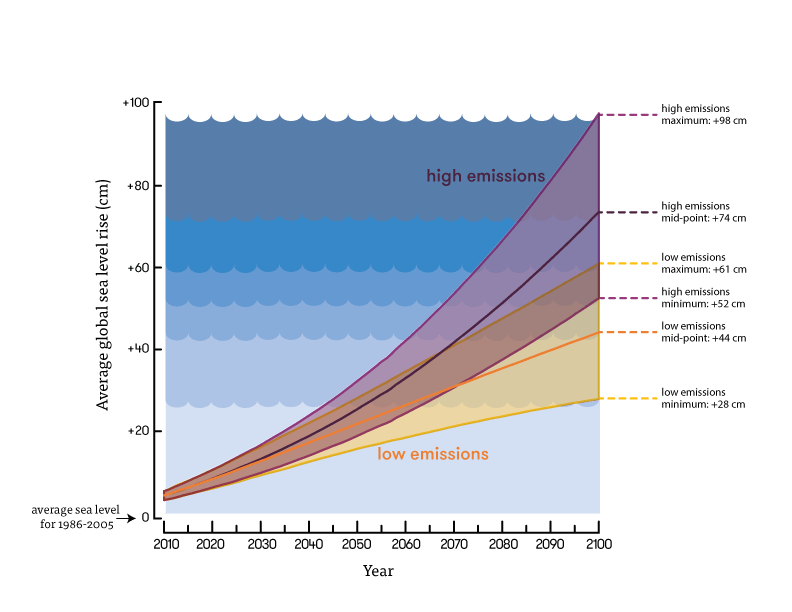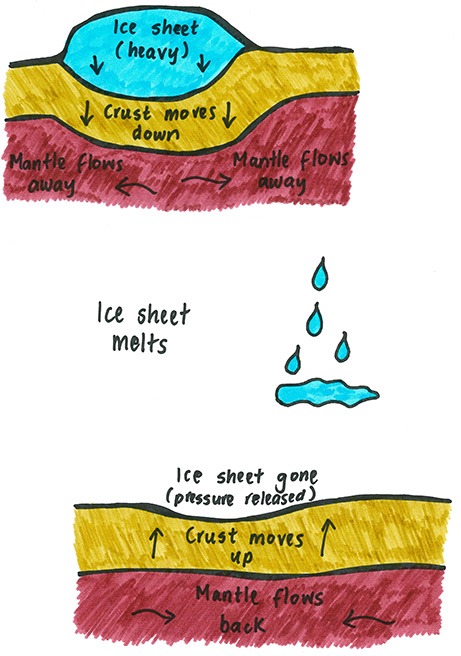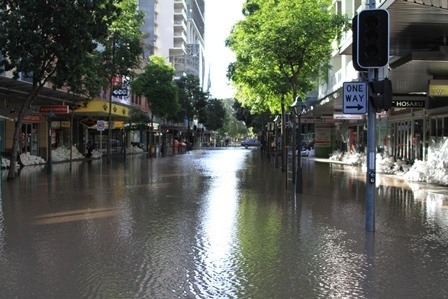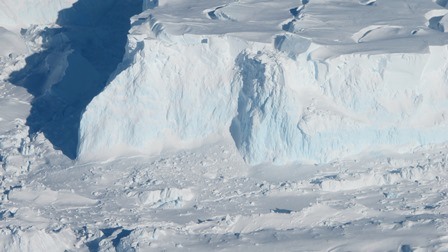In too deep? Climate change and rising sea level
Expert reviewers
Essentials
- Increasing atmospheric greenhouse gas concentrations in the atmosphere are causing global air and ocean temperatures to rise
- As air temperature increases, glaciers and ice sheets shrink—they lose more ice from melting and calving (iceberg formation) than they gain from snowfall—and this adds more water to the ocean
- As oceans become warmer, the water expands (like liquid in a thermometer) and this increases the volume of the ocean water
- Both the addition of extra water, and the thermally expanded water cause sea level to rise
- Sea level has changed throughout the Earth’s history
- Since 1900, sea level has risen by 19 centimetres—and has risen at a much faster rate than over the previous several thousand years of Earth’s history.
- Higher sea levels cause an increase in coastal flooding and erosion and threaten low-lying coastal communities and infrastructure
Earth is no stranger to sea levels higher than those we are used to today. Around 3 million years ago, average global ocean temperatures were 2–3°C higher than today, with comparable levels of atmospheric carbon dioxide (CO2). Global sea level was up to 25 metres higher, enough to submerge the cities of London and New York, while in Australia, our shorelines would have looked vastly different. Ice ages, with their accompanying changes in sea level, then came and went, largely caused by changes in the Earth’s orbit around the Sun.
Slightly more recently, around 120,000 years ago, temperatures were again warmer than today and sea level was between 5 and 10 metres higher. Following this period came the most recent ice age (also known as the Last Glacial Maximum), which spanned the period of around 26,000–19,000 years ago. Huge amounts of water were taken up in the vast ice sheets that covered Canada and the northern USA, Greenland, Scandinavia and northern Europe and the British Isles, driving sea level down to levels around 130 metres lower than today.
The end of this ice age, around 20,000 years ago, saw rapid melting and sea level rise on the order of 1 metre per century for around 13,000 years. There were also periods of more rapid rise—around 14,200 years ago sea level rose more than 10 metres over around 300 years. From around 6,000 years ago, sea level has been comparatively stable, with a slow gradual rise of a few centimetres per century.
Since 1900, though, we have witnessed a rise in sea level of around 19 centimetres.
Higher temperatures = higher sea levels
Higher sea levels are the result of higher average global temperatures. The large-scale addition of greenhouse gases to the atmosphere since the Industrial Revolution has changed the way our planet’s climate system works, with the end result that the Earth is getting warmer. Average global temperatures have increased by around 0.85°C since 1850.
Warmer temperatures result in higher sea levels because as the land and lower atmosphere of the world warm, heat is transferred into the oceans. When materials are heated they expand (thermal expansion). This thermal expansion increases the ocean’s volume, resulting in a rise in sea level.
In addition, warmer temperatures will cause shrinkage of land-based ice such as glaciers and ice sheets lose more ice through melting and calving to form icebergs as they meet the ocean, than they gain from snowfall. This extra water enters the ocean, also adding to sea level rise.
A point to remember is that no extra water is added to the oceans when ice floating in the ocean melts. As floating ice melts, it only replaces the volume of water that it originally displaced.
Melting or expansion?
Which contributes the most to sea-level rise—melting ice or the thermal expansion of water? The answer depends on the time-scale you're interested in.
Since the 1970s, ocean thermal expansion has contributed around 40 per cent of the observed rise, with a similar amount from glaciers and ice sheets. The ice sheets stand to make a more significant contribution in the future. Extraction of groundwater, which eventually ends up in the oceans after its use on land, also made a small contribution, around 5 per cent.
How much higher?
Under a scenario of low future greenhouse gas emissions, average global sea level is expected to rise by 28–61 centimetres by 2100. This low emission scenario would require a significant and urgent reduction in greenhouse gas emissions.
For a business-as-usual, high emissions scenario, the prediction is for a rise of 52–98 centimetres.

This rate of sea level rise is similar to that seen at the end of the last ice age, where the major climate shift between glacial and non-glacial periods resulted in sea-level rise of around 1metre per century, with peak rakes of 4 metres per century.
Not the same everywhere
As well as the range in average global sea-level projections, the rate and magnitude of regional sea-level change will vary from place to place in response to changes in ocean currents and vertical movements of the land itself. Local tectonic activity can cause land masses to either uplift (with a local drop in sea level) or subside (causing a rise in sea level). Subsidence is also caused by the compaction of sediments in river delta areas, such as Bangladesh and Vietnam.
A massive ice sheet is very heavy. When it melts, and the pressure exerted by its weight is lessened, the Earth’s crust responds by ‘rebounding’ upwards. Known as isostatic rebound, this can also affect regional sea level.

The shifts caused by isostatic rebound can can also go in either direction. Sea level at Stockholm and the east coast of Canada has decreased as the land mass has slowly uplifted in response to the loss of ice sheets from the last ice age, while along north-eastern coast of the United States, sea level has risen as land subsides slightly in response to the movement of the molten mantle northward beneath the uplifting land mass of Canada.
The large mass of a huge ice sheet can exert a gravitational pull over the nearby ocean, which lessens as that ice sheet loses mass (melts). This process causes a drop in sea level locally, but an increase in sea level further away as the water ‘sloshes’ away from the diminishing ice sheet to other regions of the ocean. This can cause an increase in sea level of up to 20–30 per cent higher than the global average.
What is the impact of 50 centimetres?
Current estimates put sea level rise by 2100 at between 26 and 98 centimetres. A figure between these two values—50 centimetres—doesn’t sound too dramatic. Maybe you'll just have to build your sandcastles a little higher up the beach.
The reality promises to be a little grimmer. Because of the shallow gradient of many coastlines, a vertical increase of 50 centimetres would actually cover a lot of ground. In many places, 50 centimetres would see entire beaches being washed away, together with a significant chunk of the coastline if no remedial action is taken. We already put a lot of effort into maintaining beaches along the Australian east coast, as natural processes tend to shift a lot of sand northwards along the coastline, which then has to be transported back to keep our beaches sandy. Many coastal plain areas already have ground that is lower than the high tide level yet are still currenlty protected from the ocean. These may be 'reconnected' to the sea, and undergo extensive flooding.
For people living on low-lying islands such as Tuvalu, Kiribati or the Maldives, where the majority of the islands are only 2–3 metres above current sea levels, an extra 50 centimetres could see significant portions of their islands being washed away by erosion or, more significantly, covered by water and more vulnerable to storm events.
Even if they remain above the sea, many island nations will have their supplies of drinking water reduced because sea water will invade their freshwater aquifers.
While these islands have sizeable populations, consider the millions of people living in the low-level coastal areas of southern Asia. These include the coastlines and deltaic plains of Pakistan, India, Sri Lanka, Bangladesh, Vietnam and Burma. The Red River and the Mekong River delta regions in Vietnam are home to around 40 million people, and the Ganges-Brahamutra delta in Banglasesh and western India is one of the most densely populated regions in the world, with around 130 million people. Sea level rise will compound upon the existing stresses these regions already face from coastal flooding and storm surges.
Australian coasts
Around 85 per cent of Australia’s population lives close to the coast. Although we generally haven’t built right up the shoreline, there is a lot of development along estuaries and coastal plains slightly inland from the beach. Many of these coastal plains are lower than the current high tide level, making them vulnerable to extensive flooding with an increase in sea level.
A general rule of thumb used by engineers and planners is that for each centimetre of vertical sea level rise may see sandy beaches retreat by up to one metre. Although this rule varies from place to place, it has some fairly dramatic implications if we do see the full 98 centimetres—the upper end of the IPCC projected scenarios—of sea level rise by 2100.
Floods already cause significant damage in Australia. CSIRO researchers believe that a 40cm rise in sea level could see damage costs associated with coastal flooding more than double in southern Queensland and northern New South Wales. A 50 centimetres increase in sea level could see extreme 1-in-100-year storm surge heights occurring every year.

Low-lying coastal ecosystems, such as the freshwater wetlands that make up about 90 per cent of the coastal zone of Kakadu in the Northern Territory, are also vulnerable. Hundreds of species of birds, reptiles and amphibians depend on these freshwater areas. Intrusion of salt water is already a major management issue in Kakadu. If sea levels around Australia rise by around 50 centimetres, these freshwater wetlands will become saltier. A 1 metre rise in sea level would transform Kakadu’s low-lying coastal plains and some of the freshwater wetlands they support into mangrove forest.
Future planning should take potential future sea-level rises into consideration. For example, building protective sea walls, and being realistic about the risks of coastal development are measures that could minimise damage from rising sea levels over the next century.
Rough waters ahead
We are on course to see higher sea levels in the future—possibly by as much as a metre by the end of this century. Sea levels have changed throughout the Earth’s history, so our planet is well-accustomed to change of this nature. The question is, are we?






